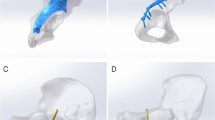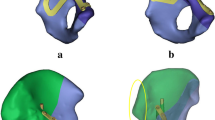Abstract
We used a three-dimensional finite element method to investigate the conditions behind the Kerboull-type (KT) dome. The KT plate dome was divided into five areas, and 14 models were created to examine different conditions of dome contact with the acetabulum. The maximum stress on the KT plate and screws was estimated for each model. Furthermore, to investigate the impact of the contact area with the acetabulum on the KT plate, a multiple regression analysis was conducted using the analysis results. The dome–acetabulum contact area affected the maximum equivalent stress on the KT plate; good contact with two specific areas of the vertical and horizontal beams (Areas 3 and 5) reduced the maximum equivalent stress. The maximum equivalent stress on the hook increased when the hardness of the bone representing the acetabulum varied. Thus, we confirmed the technical importance of providing a plate with a broad area of appropriate support from the bone and cement in the posterior portion of the dome and also proved the importance of supporting the area of the plate in the direction of the load at the center of the cross-plate and near the hook.






Similar content being viewed by others
References
Buttaro MA, Comba F, Pusso R, Piccaluga F (2008) Acetabular revision with metal mesh, impaction bone grafting, and a cemented cup. Clin Orthop Relat Res 466:2482–2490
Lee J-M, Nam H-T (2011) Acetabular revision total hip arthroplasty using an impacted morselized allograft and a cementless cup: minimum 10-year follow-up. J Arthroplasty 26:1057–1060
Jones L, Grammatopoulos G, Singer G (2011) The Burch-Schneider cage: 9-year survival in Paprosky type 3 acetabular defects. Clinical and radiological follow-up. Hip Int 22:28–34
Mibe J, Imakiire A, Watanabe T, Fujie T (2005) Results of total hip arthroplasty with bone graft and support ring for protrusio acetabuli in rheumatoid arthritis. J Orthop Sci 10:8–14
Uchiyama K, Takahira N, Fukushima K, Yamamoto T, Moriya M, Itoman M (2010) Radiological evaluation of allograft reconstruction in acetabulum with Ganz reinforcement ring in revision total hip replacement. J Orthop Sci 15:764–771
Kerboull M, Hamadouche M, Kerboull L (2000) The Kerboull acetabular reinforcement device in major acetabular reconstructions. Clin Orthop Relat Res 378:155–168
Akiyama H, Yamamoto K, Tsukanaka M, Kawanabe K, Otsuka H, So K, Goto K, Nakamura T (2011) Revision total hip arthroplasty using a Kerboull-type acetabular reinforcement device with bone allograft: minimum 4.5-year follow-up results and mechanical analysis. J Bone Jt Surg Br 93:1194–1200
Crowninshield RD, Maloney WJ, Wentz DH, Humphrey SM, Blanchard CR (2004) Biomechanics of large femoral heads: what they do and don’t do. Clin Orthop Relat Res 429:102–107
Kawai T, Tanaka C, Ikenaga M, Kanoe H, Okudaira S (2010) Total hip arthroplasty using Kerboull-type acetabular reinforcement device for rapidly destructive coxarthrosis. J Arthroplasty 25:432–436
Kawanabe K, Akiyama H, Onishi E, Nakamura T (2007) Revision total hip replacement using the Kerboull acetabular reinforcement device with morsellised or bulk graft: results at a mean follow-up of 8.7 years. J Bone Jt Surg (Br) 89:26–31
Lunn JV, Kearns SS, Quinlan W, Murray P, Byrne JO (2005) Impaction allografting and the Kerboull acetabular reinforcement device: 35 hips followed for 3–7 years. Acta Orthop 76:296–302
Okano K, Miyata N, Enomoto H, Osaki M, Shindo H (2010) Revision with impacted bone allografts and the Kerboull cross plate for massive bone defect of the acetabulum. J Arthroplasty 25:594–599
Tanaka C, Shikata J, Ikenaga M, Takahashi M (2003) Acetabular reconstruction using a Kerboull-type acetabular reinforcement device and hydroxyapatite granules: a 3-to 8-year follow-up study1 1No benefits or funds were received in support of this study. J Arthroplasty 18:719–725
Wegrzyn J, Pibarot V, Jacquel A, Carret J-P, Béjui-Hugues J, Guyen O (2014) Acetabular reconstruction using a Kerboull cross-plate, structural allograft and cemented dual-mobility cup in revision THA at a minimum 5-year follow-up. J Arthroplasty 29:432–437
Hurwitz DE, Foucher KC, Andriacchi TP (2003) A new parametric approach for modeling hip forces during gait. J Biomech 36:113–119
Williams M, Lissner HR (1963) Biomechanical analysis of knee function. J Am Phys Therapy Assoc 43:93–99
Kawanabe K, Akiyama H, Goto K, Maeno S, Nakamura T (2011) Load dispersion effects of acetabular reinforcement devices used in revision total hip arthroplasty: a simulation study using finite element analysis. J Arthroplasty 26:1061–1066
Kaku N, Hara K, Tabata T, Tsumura H (2015) Influence of the volume of bone defect, bone grafting methods, and hook fixation on stress on the Kerboull-type plate and screw in total hip arthroplasty: three-dimensional finite element analysis. Eur J Orthop Surg Traumatol 25(2):321–329
Conflict of interest
Each author certifies that he or she, or a member of their immediate family, has no commercial associations (e.g., consultancies, stock ownership, equity interest, and patent/licensing arrangements) that might pose a conflict of interest in connection with the submitted article.
Author information
Authors and Affiliations
Corresponding author
Rights and permissions
About this article
Cite this article
Hara, K., Kaku, N., Tabata, T. et al. Contact between the acetabulum and dome of a Kerboull-type plate influences the stress on the plate and screw. Eur J Orthop Surg Traumatol 25, 877–883 (2015). https://doi.org/10.1007/s00590-015-1623-4
Received:
Accepted:
Published:
Issue Date:
DOI: https://doi.org/10.1007/s00590-015-1623-4




